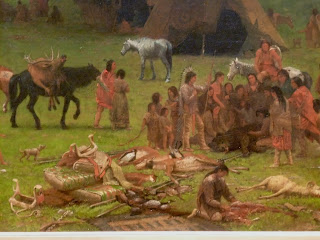Thursday, November 28, 2013
Bierstadt's Lander's Peak in the Met
All of these are my photos taken in October in the Metropolitan Museum in New York, except for the picture of the actual Lander's Peak in Wyoming at the end of this post.
Albert Bierstadt painted this picture in his studio on 10th Street in New York after returning from his first trip to the West. He displayed this painting in his studio to great acclaim from the public, if not quite universal acclaim from the critics at the time. The Sanitary Commission displayed this painting together with Frederick Church's Heart of the Andes (also in the Metropolitan and hanging across the gallery from Bierstadt's painting) to raise money for their efforts in the Civil War.
Lander's Peak Wyoming is one of Bierstadt's earliest and most famous large scale paintings showing his vision of a primeval North America that was being swept away even as he was painting it. In 1863, the forces that would eventually conquer this wilderness were unleashed.
Bierstadt based this painting on extensive sketches and notes from his travels west, though in the end, he made up all of this out of his head. Emotion informs this painting even more than scientific topography or anthropology. His painting soaks in longing and nostalgia, made even more intense by the unavoidable awareness of the industrial carnage of the American Civil War at its height in 1863. In contrast to wartime New York, he shows a peaceable Shoshone encampment by a lake at the foot of an immense, yet benevolent mountain.
The critics attacked him for exaggeration, a fair charge. The real Lander's Peak is not quite the soaring Mount Everest in this painting. And yet, this large painting, so full of splendid little anecdotal details, reminds me of Chinese landscape painting from the Song dynasty. What mattered in Chinese landscape painting was not topographical accuracy, but the re-creation of the experience of wandering through and looking at the landscape. Walking through scenery, we notice both the magnificent grand spectacles and the poignant little details; something which the Chinese painters famously re-created in their work, and which Bierstadt does in this and other later paintings. That simultaneous experience of the grand and the small is very hard for photographers to capture, and when they do, they frequently have paintings in mind. Like landscape paintings from China, Bierstadt intended this picture to be not simply taken in at a glance, but explored. Repeated viewings would always reward with some new discovery.
And here is the real Lander's Peak in Wyoming:
Subscribe to:
Post Comments (Atom)












No comments:
Post a Comment